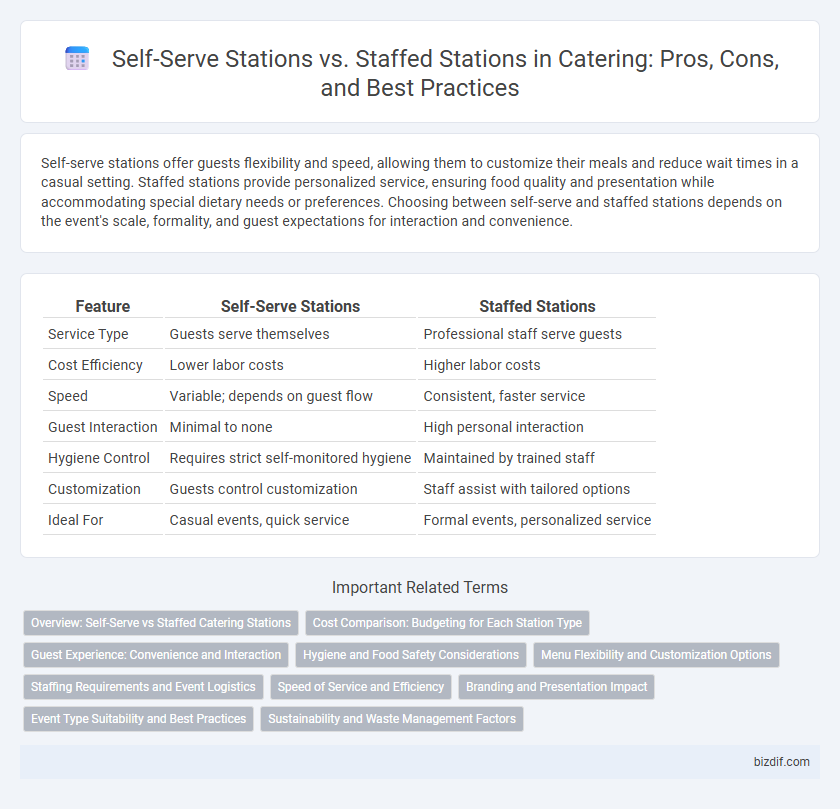Self-serve stations offer guests flexibility and speed, allowing them to customize their meals and reduce wait times in a casual setting. Staffed stations provide personalized service, ensuring food quality and presentation while accommodating special dietary needs or preferences. Choosing between self-serve and staffed stations depends on the event's scale, formality, and guest expectations for interaction and convenience.
Table of Comparison
| Feature | Self-Serve Stations | Staffed Stations |
|---|---|---|
| Service Type | Guests serve themselves | Professional staff serve guests |
| Cost Efficiency | Lower labor costs | Higher labor costs |
| Speed | Variable; depends on guest flow | Consistent, faster service |
| Guest Interaction | Minimal to none | High personal interaction |
| Hygiene Control | Requires strict self-monitored hygiene | Maintained by trained staff |
| Customization | Guests control customization | Staff assist with tailored options |
| Ideal For | Casual events, quick service | Formal events, personalized service |
Overview: Self-Serve vs Staffed Catering Stations
Self-serve catering stations empower guests with quick access to food options, reducing wait times and labor costs while enhancing customization. Staffed stations offer personalized service, ensuring food quality and dietary needs are addressed with expert attention. Combining both approaches can optimize guest experience and operational efficiency in various event settings.
Cost Comparison: Budgeting for Each Station Type
Self-serve stations reduce labor costs significantly by minimizing the need for on-site staff, making them ideal for budget-conscious catering events. Staffed stations, while more expensive due to wages and training, offer enhanced customer service and experience that can justify the higher expenditure in premium events. Balancing the cost of labor against event goals is crucial when budgeting for either self-serve or staffed catering stations.
Guest Experience: Convenience and Interaction
Self-serve stations enhance guest convenience by allowing faster access to food options, reducing wait times and enabling personalized portion control. Staffed stations elevate interaction by providing customized service, dietary guidance, and real-time meal recommendations, enriching the overall guest experience. Balancing self-serve convenience with personalized staff engagement can optimize satisfaction and streamline catering operations.
Hygiene and Food Safety Considerations
Self-serve stations increase the risk of cross-contamination and foodborne illnesses due to frequent guest handling, making strict monitoring and sanitation protocols essential. Staffed stations enhance hygiene through controlled food service, minimizing direct contact and maintaining consistent food temperature management. Implementing real-time cleaning schedules and hand sanitizing stations at both setups further supports comprehensive food safety practices.
Menu Flexibility and Customization Options
Self-serve stations offer greater menu flexibility by allowing guests to customize their meals according to personal preferences, dietary restrictions, and portion sizes without staff limitations. Staffed stations provide expert guidance and ensure consistent presentation, but may limit customization due to predetermined menu options and service pacing. Choosing the optimal option depends on balancing the need for personalized guest experiences with efficient, controlled service delivery.
Staffing Requirements and Event Logistics
Self-serve stations reduce staffing requirements by allowing guests to serve themselves, minimizing the need for attendants and lowering labor costs. Staffed stations require trained personnel to manage food presentation, assist guests, and maintain hygiene standards, increasing staffing demands and operational complexity. Event logistics for self-serve setups involve strategic placement and replenishment scheduling, while staffed stations necessitate detailed coordination of staff roles, guest flow, and real-time troubleshooting.
Speed of Service and Efficiency
Self-serve stations enhance speed of service by allowing guests to customize their meals without wait times for staff assistance, reducing bottlenecks during peak hours. Staffed stations improve efficiency in managing dietary restrictions and special requests, ensuring accuracy and customer satisfaction. Combining both approaches can optimize flow and service quality in large catering events.
Branding and Presentation Impact
Self-serve stations offer a clean, modern look that empowers guests to customize their experience, enhancing brand perception through interactive presentation. Staffed stations provide personalized service that reinforces brand values of hospitality and attentiveness, creating memorable customer interactions. Both approaches influence branding by shaping guests' sensory engagement and the overall ambiance of the catering event.
Event Type Suitability and Best Practices
Self-serve stations suit casual events such as networking mixers or large conferences by allowing guests to customize their meals independently, which reduces staffing costs and speeds up service. Staffed stations are ideal for formal occasions like weddings or corporate dinners where personalized interaction enhances guest experience and ensures portion control. Best practices involve assessing event size, guest demographics, and desired service style to determine the optimal balance between convenience and hospitality.
Sustainability and Waste Management Factors
Self-serve stations in catering typically reduce food waste by allowing guests to choose portions tailored to their appetite, enhancing sustainability through minimized leftovers. Staffed stations, while offering personalized service and potentially improved food safety, can lead to increased waste due to pre-plated servings and higher consumption rates. Implementing efficient waste management strategies, such as composting and recycling at both station types, further supports eco-friendly catering operations.
Self-Serve Stations vs Staffed Stations Infographic

 bizdif.com
bizdif.com